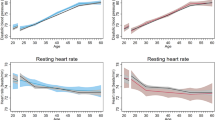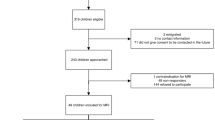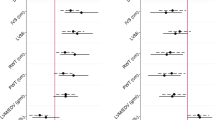Abstract
Background:
Maternal obesity may affect cardiovascular outcomes in the offspring. We examined the associations of maternal prepregnancy body mass index and gestational weight gain with childhood cardiac outcomes and explored whether these associations were explained by parental characteristics, infant characteristics or childhood body mass index.
Methods:
In a population-based prospective cohort study among 4852 parents and their children, we obtained maternal weight before pregnancy and in early, mid- and late pregnancy. At age 6 years, we measured aortic root diameter (cm) and left ventricular dimensions. We calculated left ventricular mass (g), left ventricular mass index (g m−2.7), relative wall thickness ((2 × left ventricular posterior wall thickness)/left ventricular diameter), fractional shorting (%), eccentric left ventricular hypertrophy and concentric remodeling.
Results:
A one standard deviation score (SDS) higher maternal prepregnancy body mass index was associated with higher left ventricular mass (0.10 SDS (95% confidence interval (CI) 0.08, 0.13)), left ventricular mass index (0.06 SDS (95% CI 0.03, 0.09)) and aortic root diameter (0.09 SDS (95% CI 0.06, 0.12)), but not with relative wall thickness or fractional shortening. A one SDS higher maternal prepregnancy body mass index was associated with an increased risk of eccentric left ventricular hypertrophy (odds ratio 1.21 (95% CI 1.03, 1.41)), but not of concentric remodeling. When analyzing the effects of maternal weight in different periods simultaneously, only maternal prepregnancy weight and early pregnancy weight were associated with left ventricular mass, left ventricular mass index and aortic root diameter (P-values<0.05), independent of weight in other pregnancy periods. All observed associations were independent of parental and infant characteristics, but attenuated to non-significance after adjustment for childhood body mass index.
Conclusion:
Maternal prepregnancy body mass index and weight gain in early pregnancy are both associated with offspring cardiac structure in childhood, but these associations seem to be fully explained by childhood body mass index.
This is a preview of subscription content, access via your institution
Access options
Subscribe to this journal
Receive 12 print issues and online access
$259.00 per year
only $21.58 per issue
Buy this article
- Purchase on Springer Link
- Instant access to full article PDF
Prices may be subject to local taxes which are calculated during checkout



Similar content being viewed by others
References
Tsao CW, Gona PN, Salton CJ, Chuang ML, Levy D, Manning WJ et al. Left ventricular structure and risk of cardiovascular events: a Framingham Heart Study Cardiac Magnetic Resonance Study. J Am Heart Assoc 2015; 4: e002188.
Schieken RM, Schwartz PF, Goble MM . Tracking of left ventricular mass in children: race and sex comparisons: the MCV Twin Study. Medical College of Virginia. Circulation 1998; 97: 1901–1906.
Porrello ER, Widdop RE, Delbridge LM . Early origins of cardiac hypertrophy: does cardiomyocyte attrition programme for pathological 'catch-up' growth of the heart? Clin Exp Pharmacol Physiol 2008; 35: 1358–1364.
Geelhoed JJ, El Marroun H, Verburg BO, van Osch-Gevers L, Hofman A, Huizink AC et al. Maternal smoking during pregnancy, fetal arterial resistance adaptations and cardiovascular function in childhood. BJOG 2011; 118: 755–762.
Lewandowski AJ, Augustine D, Lamata P, Davis EF, Lazdam M, Francis J et al. Preterm heart in adult life: cardiovascular magnetic resonance reveals distinct differences in left ventricular mass, geometry, and function. Circulation 2013; 127: 197–206.
Arnott C, Skilton MR, Ruohonen S, Juonala M, Viikari JS, Kahonen M et al. Subtle increases in heart size persist into adulthood in growth restricted babies: the Cardiovascular Risk in Young Finns Study. Open Heart 2015; 2: e000265.
Bateson P, Barker D, Clutton-Brock T, Deb D, D'Udine B, Foley RA et al. Developmental plasticity and human health. Nature 2004; 430: 419–421.
Huda SS, Brodie LE, Sattar N . Obesity in pregnancy: prevalence and metabolic consequences. Semin Fetal Neonatal Med 2010; 15: 70–76.
Gaillard R . Maternal obesity during pregnancy and cardiovascular development and disease in the offspring. Eur J Epidemiol 2015; 30: 1141–1152.
Block SR, Watkins SM, Salemi JL, Rutkowski R, Tanner JP, Correia JA et al. Maternal pre-pregnancy body mass index and risk of selected birth defects: evidence of a dose-response relationship. Paediatr Perinat Epidemiol 2013; 27: 521–531.
Baardman ME, Kerstjens-Frederikse WS, Corpeleijn E, de Walle HE, Hofstra RM, Berger RM et al. Combined adverse effects of maternal smoking and high body mass index on heart development in offspring: evidence for interaction? Heart 2012; 98: 474–479.
Blackmore HL, Niu Y, Fernandez-Twinn DS, Tarry-Adkins JL, Giussani DA, Ozanne SE . Maternal diet-induced obesity programs cardiovascular dysfunction in adult male mouse offspring independent of current body weight. Endocrinology 2014; 155: 3970–3980.
Fernandez-Twinn DS, Blackmore HL, Siggens L, Giussani DA, Cross CM, Foo R et al. The programming of cardiac hypertrophy in the offspring by maternal obesity is associated with hyperinsulinemia, AKT, ERK, and mTOR activation. Endocrinology 2012; 153: 5961–5971.
Ingul CB, Loras L, Tegnander E, Eik-Nes SH, Brantberg A . Maternal obesity affects foetal myocardial function already in first trimester. Ultrasound Obstet Gynecol 2015; 47: 415.
Geelhoed JJ, VANO-G L, Verburg BO, Steegers EA, Hofman A, Helbing W et al. Maternal anthropometrics in pregnancy are associated with left ventricular mass in infancy. The generation R study. Pediatr Res 2008; 63: 62–66.
Jaddoe VW, van Duijn CM, Franco OH, van der Heijden AJ, van Iizendoorn MH, de Jongste JC et al. The Generation R Study: design and cohort update 2012. Eur J Epidemiol 2012 27: 739–756.
Gaillard R, Steegers EA, Duijts L, Felix JF, Hofman A, Franco OH et al. Childhood cardiometabolic outcomes of maternal obesity during pregnancy: the Generation R Study. Hypertension 2014; 63: 683–691.
Gaillard R, Steegers EA, Franco OH, Hofman A, Jaddoe VW . Maternal weight gain in different periods of pregnancy and childhood cardio-metabolic outcomes. The Generation R Study. Int J Obes (Lond) 2015; 39: 677–685.
Taal HR, de Jonge LL, van Osch-Gevers L, Steegers EA, Hofman A, Helbing WA et al. Parental smoking during pregnancy and cardiovascular structures and function in childhood: the Generation R Study. Int J Epidemiol 2013; 42: 1371–1380.
Geelhoed MJ, Snijders SP, Kleyburg-Linkers VE, Steegers EA, van Osch-Gevers L, Jaddoe VW . Reliability of echocardiographic measurements of left cardiac structures in healthy children. Cardiol Young 2009; 19: 494–500.
Schiller NB, Shah PM, Crawford M, DeMaria A, Devereux R, Feigenbaum H et al. Recommendations for quantitation of the left ventricle by two-dimensional echocardiography. American Society of Echocardiography Committee on Standards, Subcommittee on Quantitation of Two-Dimensional Echocardiograms. J Am Soc Echocardiogr 1989; 2: 358–367.
Devereux RB, Alonso DR, Lutas EM, Gottlieb GJ, Campo E, Sachs I et al. Echocardiographic assessment of left ventricular hypertrophy: comparison to necropsy findings. Am J Cardiol 1986; 57: 450–458.
Khoury PR, Mitsnefes M, Daniels SR, Kimball TR . Age-specific reference intervals for indexed left ventricular mass in children. J Am Soc Echocardiogr 2009; 22: 709–714.
Lang RM, Bierig M, Devereux RB, Flachskampf FA, Foster E, Pellikka PA et al. Recommendations for chamber quantification: a report from the American Society of Echocardiography's Guidelines and Standards Committee and the Chamber Quantification Writing Group, developed in conjunction with the European Association of Echocardiography, a branch of the European Society of Cardiology. J Am Soc Echocardiogr 2005; 18: 1440–1463.
de Simone G, Daniels SR, Kimball TR, Roman MJ, Romano C, Chinali M et al. Evaluation of concentric left ventricular geometry in humans: evidence for age-related systematic underestimation. Hypertension 2005; 45: 64–68.
Heppe DH, Medina-Gomez C, Hofman A, Franco OH, Rivadeneira F, Jaddoe VW . Maternal first-trimester diet and childhood bone mass: the Generation R Study. Am J Clin Nutr 2013; 98: 224–232.
Jaddoe VW, Mackenbach JP, Moll HA, Steegers EA, Tiemeier H, Verhulst FC et al. The Generation R Study: design and cohort profile. Eur J Epidemiol 2006; 21: 475–484.
Niklasson A, Ericson A, Fryer JG, Karlberg J, Lawrence C, Karlberg P . An update of the Swedish reference standards for weight, length and head circumference at birth for given gestational age (1977-1981). Acta Paediatr Scand 1991; 80: 756–762.
Fredriks AM, van Buuren S, Burgmeijer RJ, Meulmeester JF, Beuker RJ, Brugman E et al. Continuing positive secular growth change in the Netherlands 1955-1997. Pediatr Res 2000; 47: 316–323.
Keijzer-Veen MG, Euser AM, van Montfoort N, Dekker FW, Vandenbroucke JP, Van Houwelingen HC . A regression model with unexplained residuals was preferred in the analysis of the fetal origins of adult diseases hypothesis. J Clin Epidemiol 2005; 58: 1320–1324.
Sterne JA, White IR, Carlin JB, Spratt M, Royston P, Kenward MG et al. Multiple imputation for missing data in epidemiological and clinical research: potential and pitfalls. BMJ 2009; 338: b2393.
Hochner H, Friedlander Y, Calderon-Margalit R, Meiner V, Sagy Y, Avgil-Tsadok M et al. Associations of maternal prepregnancy body mass index and gestational weight gain with adult offspring cardiometabolic risk factors: the Jerusalem Perinatal Family Follow-up Study. Circulation 2012; 125: 1381–1389.
Lawlor DA, Najman JM, Sterne J, Williams GM, Ebrahim S, Davey Smith G . Associations of parental, birth, and early life characteristics with systolic blood pressure at 5 years of age: findings from the Mater-University study of Pregnancy and its Outcomes. Circulation 2004; 110: 2417–2423.
Drake AJ, Reynolds RM . Impact of maternal obesity on offspring obesity and cardiometabolic disease risk. Reproduction 2010; 140: 387–398.
Lawlor DA, Smith GD, O'Callaghan M, Alati R, Mamun AA, Williams GM et al. Epidemiologic evidence for the fetal overnutrition hypothesis: findings from the mater-university study of pregnancy and its outcomes. Am J Epidemiol 2007; 165: 418–424.
Zielinsky P, Piccoli AL Jr . Myocardial hypertrophy and dysfunction in maternal diabetes. Early Hum Dev 2012; 88: 273–278.
Black D, Bryant J, Peebles C, Davies L, Inskip H, Godfrey K et al. Increased regional deformation of the left ventricle in normal children with increased body mass index: implications for future cardiovascular health. Pediatr Cardiol 2014; 35: 315–322.
Mangner N, Scheuermann K, Winzer E, Wagner I, Hoellriegel R, Sandri M et al. Childhood obesity: impact on cardiac geometry and function. JACC Cardiovasc Imaging 2014; 7: 1198–1205.
Di Bonito P, Moio N, Sibilio G, Cavuto L, Sanguigno E, Forziato C et al. Cardiometabolic phenotype in children with obesity. J Pediatr 2014; 165: 1184–1189.
Tadic M, Cuspidi C . Childhood obesity and cardiac remodeling: from cardiac structure to myocardial mechanics. J Cardiovasc Med (Hagerstown) 2015; 16: 538–546.
Dandel M, Lehmkuhl H, Knosalla C, Suramelashvili N, Hetzer R . Strain and strain rate imaging by echocardiography—basic concepts and clinical applicability. Curr Cardiol Rev 2009; 5: 133–148.
Yaktine AL, Rasmussen KM, Weight Gain During . Pregnancy: Reexamining the Guidelines. National Academies Press: Washington, DC, USA, 2009.
Fraser A, Tilling K, Macdonald-Wallis C, Sattar N, Brion MJ, Benfield L et al. Association of maternal weight gain in pregnancy with offspring obesity and metabolic and vascular traits in childhood. Circulation 2010; 121: 2557–2564.
Rowland TW . Effect of obesity on cardiac function in children and adolescents: a review. J Sports Sci Med 2007; 6: 319–326.
Daniels SR, Kimball TR, Morrison JA, Khoury P, Witt S, Meyer RA . Effect of lean body mass, fat mass, blood pressure, and sexual maturation on left ventricular mass in children and adolescents. Statistical, biological, and clinical significance. Circulation 1995; 92: 3249–3254.
Gishti O, Gaillard R, Durmus B, Abrahamse M, van der Beek EM, Hofman A et al. BMI, total and abdominal fat distribution, and cardiovascular risk factors in school-age children. Pediatr Res 2015; 77: 710–718.
Kopelman PG . Obesity as a medical problem. Nature 2000; 404: 635–643.
Toprak A, Wang H, Chen W, Paul T, Srinivasan S, Berenson G . Relation of childhood risk factors to left ventricular hypertrophy (eccentric or concentric) in relatively young adulthood (from the Bogalusa Heart Study). Am J Cardiol 2008; 101: 1621–1625.
Sabo RT, Yen MS, Daniels S, Sun SS . Associations between childhood body size, composition, blood pressure and adult cardiac structure: the Fels Longitudinal Study. PLoS One 2014; 9: e106333.
Acknowledgements
We gratefully acknowledge the contribution of the participating children, their mothers, general practitioners, hospitals, midwives and pharmacies in Rotterdam. The Generation R Study is conducted by the Erasmus Medical Center in close collaboration with the School of Law and Faculty of Social Sciences of the Erasmus University Rotterdam, the Municipal Health Service Rotterdam area, Rotterdam, the Rotterdam Homecare Foundation, Rotterdam and the Stichting Trombosedienst and Artsenlaboratorium Rijnmond (STAR), Rotterdam. The general design of Generation R Study is made possible by financial support from the Erasmus MC, University Medical Center, Rotterdam, the Netherlands Organization for Health Research and Development (ZonMw), the Netherlands Organisation for Scientific Research (NWO), zthe Ministry of Health, Welfare and Sport and the Ministry of Youth and Families. VWVJ received an additional grant from the Netherlands Organization for Health Research and Development (VIDI 016. 136. 361) and a European Research Council Consolidator Grant (ERC-2014-CoG-648916). This research was partly funded by the European Commision’s Horizon 2020 Programme: EU H2020-PHC-2014—grant no. 633595: DynaHEALTH—understanding the dynamic determinants of glucose homeostasis and social capability to promote healthy and active aging and by the European Union's Seventh Framework Programme (FP7/2007-2013), project EarlyNutrition under grant agreement no. 289346.
Author information
Authors and Affiliations
Corresponding author
Ethics declarations
Competing interests
The authors declare no conflict of interest.
Additional information
Supplementary Information accompanies this paper on International Journal of Obesity website
Supplementary information
Rights and permissions
About this article
Cite this article
Toemen, L., Gishti, O., van Osch-Gevers, L. et al. Maternal obesity, gestational weight gain and childhood cardiac outcomes: role of childhood body mass index. Int J Obes 40, 1070–1078 (2016). https://doi.org/10.1038/ijo.2016.86
Received:
Revised:
Accepted:
Published:
Issue Date:
DOI: https://doi.org/10.1038/ijo.2016.86
This article is cited by
-
Lifestyle intervention in obese pregnancy and cardiac remodelling in 3-year olds: children of the UPBEAT RCT
International Journal of Obesity (2022)
-
Normalisation of circulating adiponectin levels in obese pregnant mice prevents cardiac dysfunction in adult offspring
International Journal of Obesity (2020)
-
Maternal obesity, gestational weight gain and childhood cardiac outcome at age 6 years
International Journal of Obesity (2017)
-
Response to ‘Maternal obesity, gestational weight gain and childhood cardiac outcome at age 6 years’
International Journal of Obesity (2017)
-
The Generation R Study: design and cohort update 2017
European Journal of Epidemiology (2016)



